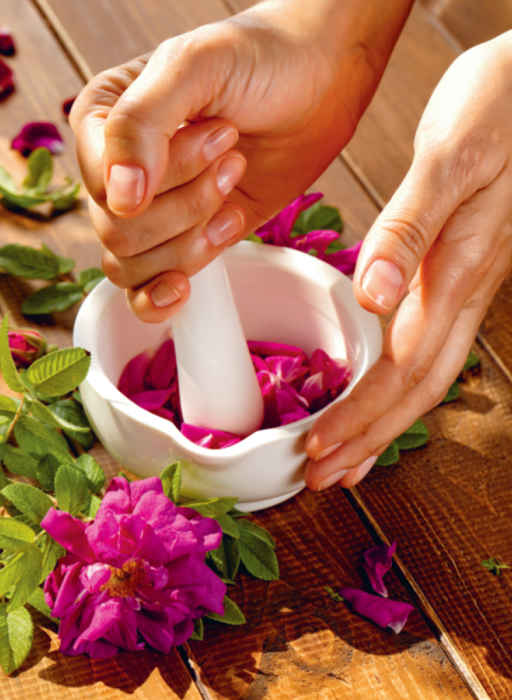
Perfume has been in use for more than 8,000 years. Ancient records suggest that the earliest perfumes were found in the East and Far East, especially in India, China and Japan. The Egyptians were renowned for their perfumery expertise, as were the Greeks and Romans in the Western world. The word ‘perfume’ literally means ‘through the smoke’, from the Latin per fumare: burning fragrant plants and woods as incense and for fumigation was the earliest type of perfume. Scents, incense and spices played an intrinsic role in the daily rituals of all these ancient civilisations: for use in religious rites, especially those concerning death, for the maintenance of health and hygiene, as well as for aesthetic purposes and for sensual pleasure.
Aromatics were believed to have the ability to alter states of consciousness, both by lifting the spirits and by driving out evil influences in cases of mental illness. Frankincense, for example, has the capacity to transform moods and is used extensively in the Catholic church. German research in the 1980s has shown that it contains a substance called trahydrocannabinol, which directly affects the imagination.
The Egyptians, in particular, were masters of aromatic alchemy, the art of making fragrant elixirs that could bring about an altered state of consciousness – like their famous perfume Kyphi. For them, scent was a link with the divine and they referred to perfume as ‘fragrance of the gods’. Both the Greeks and the Romans also used perfumes and aromatic oils extensively and had considerable understanding of their psycho-therapeutic properties. The physician Marestheus maintained that certain scents, such as rose or hyacinth, had uplifting and euphoric qualities, while Hippocrates recommended a daily massage with aromatic oils to promote a healthy body and mind, and to prolong life.
The Arab world and the Orient likewise enjoyed a passion for scent, although they had different ingredients at their disposal. Perfume materials such as sandalwood, cedar and jasmine, together with a whole array of spices such as cardamom, ginger and clove gave the oriental products a rich and sensual allure. These aromatic raw materials of perfumery, being both costly and in great demand, were among the first items to be traded between East and West. Clay pots used for distilling essential oils from plants, dating back to 3,500 BC, have been found in Mesopotamia, but it was not until the eleventh century AD under the Arab physician Avicenna that the art of distillation was perfected. This new process of steam distillation was critical to the development of perfumery as a whole, and it was from Arabia that knowledge of aromatics and perfume-making was first brought to medieval Europe.
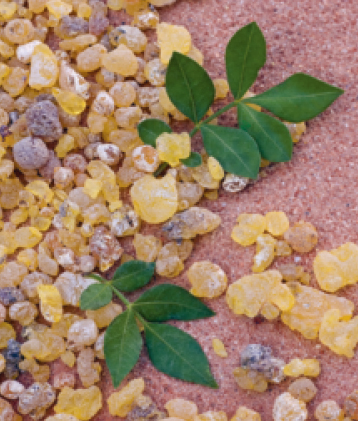
Frankincense leaves and resin.
All early perfumes were made wholly from natural ingredients, using fragrant petals, seeds, roots or bark, together with scented gums and resins, as well as a small number of products derived from animals, such as musk. The first body perfumes were called unguents and were a type of ointment made by simply immersing the aromatic material in an oily or fatty base – a process called ‘enfleurage’. Later, fragrant essential oils were extracted from the raw material in a variety of ways – by simple pressure (as is the case with most citrus oils), or by steam distillation (most essential oils are still made in this manner). As the formulation and production of perfumes became more sophisticated, they took on a whole range of different forms, including scented powders, flower waters, aromatic infusions and room fresheners, as well as concentrated essences. Then with the discovery of the alcoholic extraction process in the fourteenth century, the art of perfumery assumed a new finesse.
The first books explaining perfumery techniques began to appear at the beginning of the early sixteenth century in Europe and it became common for women to prepare their own perfumes in a special still room – literally a distillation room.
The still room was used primarily for making aromatic substances of hygienic and medicinal value, and secondarily for making flavoured vinegars or oils and aromatic wines and cordials, as well as for drying culinary herbs. In larger houses there was often another room used solely for the drying of herbs, but in smaller households both activities took place in the same place. The task of making these home remedies, fragrant waters, perfumes, cosmetics, scented soaps and candles, moth repellents and pot pourri, was carried out by the ladies of the household, and often required a certain skill. Most of the recipes for still-room preparations were handed on orally but some ‘receipts’ have been preserved by families recording their medical and perfumery knowledge. Mary Doggett in 1682, for example, noted down one of the finest recipes for a ‘sweet bagg’ using a mixture of orris, rosewood, coriander seeds, oranges, cloves, lemon peel, damask leaves, marjoram, juniper, sweet flag and cypress roots.
Roses were used extensively for making flower waters, while linens, writing paper and clothes were scented with aromatic herbs such as lavender. A fragrant cosmetic water made from lily-of-the-valley and known as ‘aqua aurea’, was used as a beauty aid, while myrtle flowers were used to make a popular skin tonic called angel flower water. Scented water was also frequently sprinkled on the floors of Elizabethan rooms, which were usually strewn with scented rushes or bay. The lemonscented juice from the leaves and stem of lemon balm or the seeds of sweet cicely were used to polish heavy oak furniture and flooring, imparting their sweet perfume to the wood.
Scented woods and herbs were burned to prevent the spread of infection but also to help get rid of musty smells. The Deanery of St Paul's was fumigated twice a week with aromatics such as rue or angelica root during the Great Plague of 1665. Pot pourri was made from a wide range of flowers and petals, in both a dry and a moist form. Indeed, over the following centuries in Europe, home-grown aromatic plants and herbs were used to make a wide range of different perfume materials, and this did not change until the midnineteenth century, with the birth of modern perfumery. Modern perfumes developed from the discovery and use of synthetic fragrances. While fragrances from natural compounds make up a well-documented and traditional inventory, synthetic scents, which only emerged 150 years ago, can provide a limitless source of cheaper and reliable ‘notes’ or fragrances. Chemistry's first inroads into classical perfumery date from 1830, when cinnamon, aniseed and pine revealed their secret aromatic ingredients: cinnamic acid, anethole and borneol. Ten years later, the face of perfumery was dramatically changed again with the discovery of aldehydes – the key to the formula of Chanel No. 5. Since then, the scientific approach to perfumery has taken over to the extent that virtually all commercial perfumes and toiletry products on the market today are made almost entirely from synthetic materials.
An increasing number of people, however, are developing an adverse reaction to the mass of chemicals that surround us in the modern world, and are seeking out products that are 100 per cent natural. The growing interest in the field of aromatherapy is having a notable effect on the perfumery world, with many cosmetic and perfumery houses moving towards a more natural emphasis. All perfumes are now described in botanical terms such as ‘floral’, ‘mossy’, ‘woody’ or as containing jasmine, rose or oakmoss, for example. Meanwhile, the aromatherapy industry itself is moving in the direction of mainstream perfumery by becoming more sophisticated and far-reaching in its impact, thus producing a merging of the two disciplines.
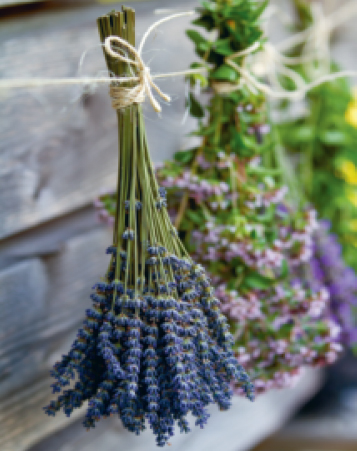
The still room was used for drying herbs and plants, among other things.
Scents are wide-ranging. They were originally defined by Theophrastus as falling into two categories, good and evil, and only distinguished by degrees using such terms as pungent, powerful, faint, sweet or heavy. They were subsequently re-defined by Linnaeus in the eighteenth century into further subdivisions, such as fragrant, aromatic or ambrosiac – the good categories; or alliaceous (smelling like garlic), foul or hircine (goat-like) – the bad categories. In the following century, a more sophisticated classification was used by Rimmel in his Book of Perfumes, in which he identified eighteeen different aromatic groups, including anise, balsamic, jasmine, citrine, rosaceous, sandal, spicy, tuberose and violet.
Also in the nineteenth century, a Frenchman called Piesse instigated a new approach to perfumery work by classifying odours according to the notes in a musical scale. His vision continues to provide inspiration in perfumery work today, since fragrances are still defined as having ‘top’, ‘middle’ and ‘base’ notes. The top note has a fresh light quality, which is immediately apparent; the middle note provides the heart of the fragrance, which emerges some time after the first impression; the base note is the heavy element which helps fix the higher notes and stop them from evaporating too quickly. Individual scents can also be classified into these three groups. Lemon, pine and eucalyptus may be called top-note oils; middlenote essences range from geranium to marjoram and lavender; while base-note fragrances include frankincense, sandalwood and benzoin.
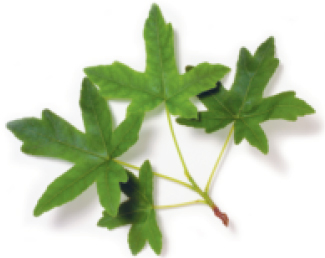
Liquidambar orientalis, part of the ‘aromatic group’ of flower scents.
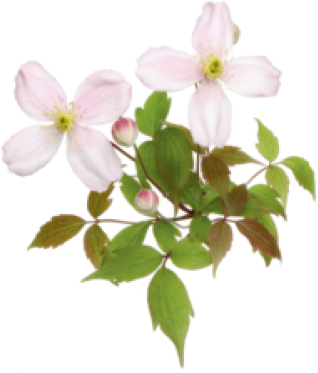
Mountain clematis (Clematis montana), part of the ‘aromatic group’ of flower scents.
A more comprehensive classification of scent was made in 1893 by Count von Marilaun, who arranged flower perfumes into six main groups based on the main chemical constituents present in their essential oil – the part of the plant that gives each its specific fragrance – including the indoloid, aminoid, benzoloid, terpenoid and paraffinoid groups. However, this categorisation was still not sophisticated enough to cover all plant-based fragrances and was later expanded to include ten separate flowerscent categories, four leaf categories and two main wood or bark categories. In brief, these are as follows:
1 Indoloid group Generally purple or brownish flowers that all have a meaty smell – Trillium erectum and a number of fritillaries.
2 Aminoid group Generally dingy white or cream flowers that have a fishy smell – Pyracantha and Sorbus species.
3 Heavy group Mostly white or pale cream flowers containing some aminoids, that smell sweeter and more floral at a distance but at close quarters they can take on an overpowering, unpleasant smell of putrefaction – Lilium candidum, Polianthes tuberosa, Osmanthus, some members of the Syringa, Philadelphus and Daphne genuses and types of narcissus and jonquil.
4 Aromatic group Mainly white, yellow or pale pink flowers with a pleasing balsamic, vanilla or almond-like fragrance – Cyclamen creticum, Clematis montana, C. flammula, several Lonicera species, Choisya ternata, heliotrope, sweet peas, pinks and carnations, plus leaves of Liquidambar orientalis.
5 Violet group Plants that have self-fertilising flowers with a violet scent, quickly fading to a mossy undertone – Iris reticulata, several Acacia species, plus of course purple violets and orris root (Iris florentina).
6 Rose group Flowers of variable colour having a lovely sweet-floral, almost fruity fragrance that is not cloying – Damask roses, Pelargonium capitatum, Iris hoogiana, Paeonia suffruticosa and types of magnolia.
7 Lemon group Citrus scent is more often found in leaves than flowers – Rosa bracteata, Oenothera odorata and Nymphaea odorata; lemon eucalyptus, lemon verbena, lemon balm, and lemon thyme leaves.
8 Fruit-scented group A wide-ranging class of flowers, some scented like oranges – ‘Wedding Day’ roses; or pineapple – gorse and Cytisus battandieri; or apples – Rosa wichurana and leaves of R. rubiginosa.
9 Animal-scented group Included here are musky-scented flowers – valerian, crown imperial (Fritillaria imperialis), Rosa moschata and musk hyacinth (Muscari muscarimi) plus the leaves of the burning bush (Dictamnus albus).
10 Honey group These are sweeter than the musk scents but can be cloying – clover, meadowsweet, honeysuckle and various Buddleja species.
1 Turpentine group Rosemary.
2 Camphor group Sage, wormwood, eucalyptus, thyme, catmint and bay.
3 Mint group All mints, some types of eucalyptus, geranium and thyme.
4 Sulphur group Onion, garlic, chives.
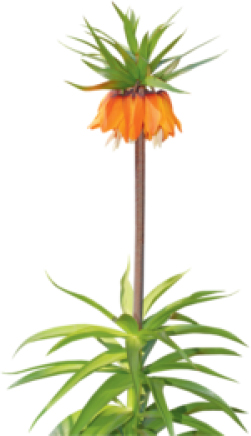
Crown imperial ‘Rubra’ (Fritillaria imperialis ‘Rubra’), part of the ‘animal-scented group’ of flower scents.
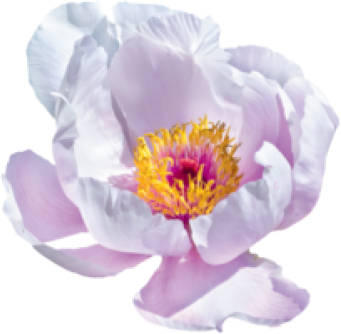
Tree peony (Paeonia suffruticosa), part of the ‘rose group’ of flower scents.
1 Aromatic group Cinnamomum camphora.
2 Turpentine group Pinus sylvestris.
For a more in-depth analysis of the chemical make-up of particular essential oils present in various plant species and their value in aromatherapy, see The Complete Aromatherapy and Essential Oil Sourcebook (Julia Lawless, HarperCollins).
However we define fragrance, its impact on us is profound. It creates a ‘sweet intoxication in the soul’ and has been used by lovers and mystics alike since time immemorial. Could we but see these varied fragrances in the form of different colours, it would be a remarkable sight in the fragrant garden. Robert Bridges puts it eloquently:
. . . if odour was visible as colour he would see the summer garden aureoled in rainbow clouds. It is easy to imagine that the butterflies on a summer afternoon are caught up in a golden bowl of light in which scent and colour are inextricably linked.
(Butterfly Gardener)
For drying purposes, flowering plants should always be picked with a good-length stem, just before they come into full bloom, on a warm day. The best time of day for picking is in the early morning after any dew has vanished: it is essential that all plants are completely dry before harvesting, otherwise they will start to turn mouldy. Check that all parts of the plant are healthy and discard any rotten or discoloured bits. Leaves should be cut when they are young and fresh; seeds should be left to sun ripen as long as possible on the plant before they are gathed.
Many plants benefit from being trimmed back in this way as a matter of course since it encourages healthy growth to clip off all the flowering stems before the autumn. (In the case of tender plants, however, major pruning should be left until spring.) Harvested material should then be hung in small loose bunches in a dark, ventilated place – an old cupboard or a dry shed is ideal – or laid out on newspaper-lined trays and slid under the bed or a chest of drawers. Alternatively, loose bundles of three or four cut stems can be placed in brown paper bags, with the neck left open and pegged to a rope line. A very gentle heat (from an Aga, open fire or airing cupboard) can help speed up the drying process, but intense heat is destructive to the plants’ properties.
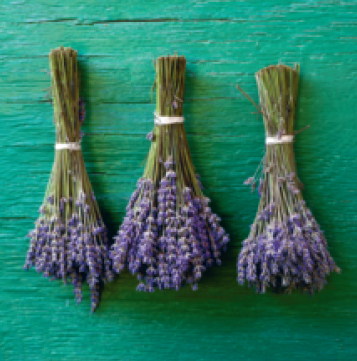
Pick flowering plants or herbs for drying with a good-length stem.

Pine cones can be used to perfume the home.
After a few weeks, check that the flowers and herbs are completely dry and brittle to the touch. Store seeds, leaves and flowers in airtight jars or in paper bags secured at the top. Don’t throw away the woody stems of aromatic plants: use them as incense or burning perfume (see below).
Bundles of dried rosemary, lavender, sage, juniper and cypress have been used for thousands of years as natural incenses, to perfume and purify the air. Simply dry the herbs, bind into bundles and throw them onto open fires or barbecues. Other aromatic materials such as orange peel, pine cones or citrus leaves, enhanced with added essential oils, can be used to perfume the house on special occasions.
It is possible to make your own minute quantities of essential oils at home using an enamel kettle (or a pressure cooker) and some rubber tubing. Pack the plant material in the kettle until it is full, then cover it with water. Attach a piece of rubber tube about 1.5m (5ft) long to the spout. Pass the rubber tubing over a bowl of ice set on a chair and then place the end of the tube in a glass container on the floor. Put the kettle on a heat source and slowly bring it to the boil. Allow it to remain just below simmering level until the water has virtually disappeared from the kettle. Repeat several times as required. Using an eye dropper, draw off the essential oil from the top of the condensed liquid in the glass container. The remaining flower water can be used as a skin tonic or light perfume.
Fill a small bottle with your chosen material, such as lily-of-the-valley flowers, rose petals, lavender or elder flowers, or citrus leaves, picked on a dry day. Top up the bottle with pure vodka and leave for a week. Strain and replace the flowers weekly for as long as the fresh flowers or leaves are in season. Eventually, the alcohol will be saturated with the scent of the flowers or herb and can be used as a concentrated eau-de-cologne. A violet perfume can be obtained by mixing 50ml (2fl oz) of vodka with 12g (½ oz) of dried orris root, which has been finely chopped, in a glass jar. Seal and leave for one week, when the alcohol will have a strong violet scent. For a lighter toilet water, mix the concentrated solution with at least an equal amount of witch-hazel water. Decant into a decorative bottle with an airtight stopper.
Pack a small glass jar with fresh flower material, such as jasmine, lilac or lily. Always choose petals or flowers that are in good condition. Fill up the jar with jojoba oil and allow to stand for 24 hours. Put the plant material in a muslin bag and squeeze the oil back into the jar. Repeat the process using fresh plant material every day for at least one week. Eventually this will produce a very concentrated enfleurage-style perfume or unguent. Essences of lily-of-the-valley, jasmine, violet and tuberose are best captured in this way as their fragrance is destroyed by heat. An alternative method, which is quicker but does not preserve the true scent in quite the same way, is to use an oil maceration process. Put a quantity of ordinary coconut butter in an enamel pan and place on a low heat so that it turns to liquid. Place the fresh plant material in the enamel pan together with the melted coconut butter and stir gently for about half an hour. Strain the coconut oil and plant matter quickly through a sieve and allow to cool. Repeat if a stronger scent is required. The solid coconut butter can be used as a perfume as it will be saturated with the fragrance of the plants used.
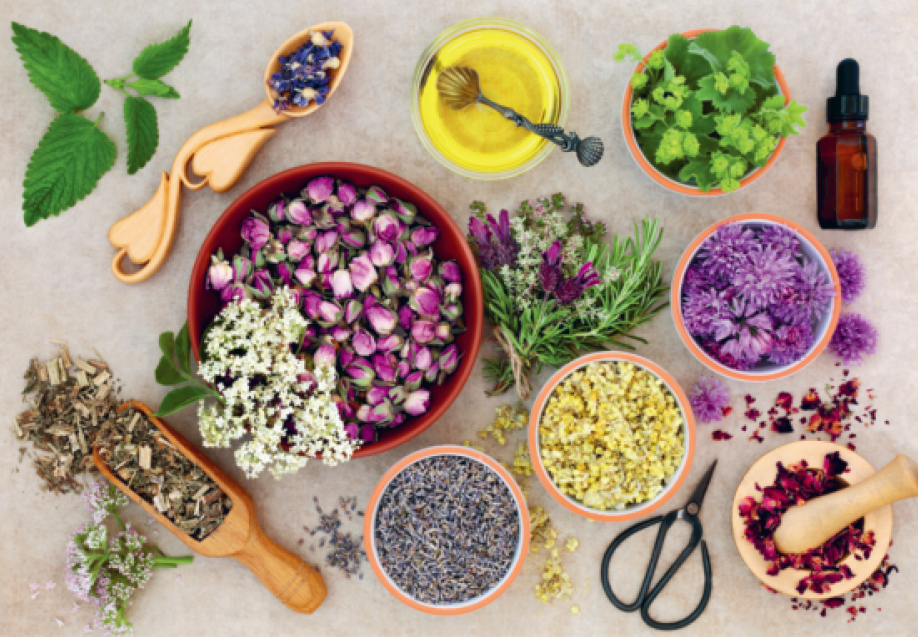
Use lily-of-the-valley to create an eau-de-cologne or toilet water.
Scented oils have medicinal uses as well as culinary. For example, infused lavender oil can help bring relief to aching limbs; chamomile-infused oil can help tummy ache; marigold oil is good for irritated skin.
Use a good-quality oil like sweet almond oil or apricot kernel oil. Fill a screw-topped jar two-thirds full with the oil. With a pestle and mortar, bruise a good handful of your chosen herb, using the ratio of 50g (2oz) plant material to 550ml (1 pint) of oil. Add about 1 tablespoon (15ml) of white wine vinegar to the herbs and add both crushed herbs and vinegar to the oil. Seal tightly and shake well. Leave the jar on a hot windowsill or, in winter, near a heater. Shake the jar once a day for about three weeks. Test the oil by rubbing it on your skin and, if the fragrance lingers, the oil is ready. If not, crush more herbs and repeat for another couple of weeks. Then strain and bottle.
There are numerous pot pourri blends available. Several recipes are included below but experimenting with different home-grown combinations can be exciting.

Elizabethan blend:
2 cups dried mixed rose petals
1 cup dried verbena leaves
½ cup dried lavender flowers
½ cup dried mint leaves
½ tablespoon orris root powder
Half a nutmeg, grated
20–25 drops rose essential oil
20–25 drops lavender essential oil
Decorative rosebuds
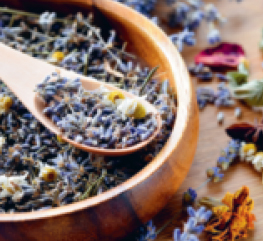
Experiment with your own combinations of dried herbs or aromatic flowers to create pot pourri.

Lapis lazuli blend:
With its fresh colouring and fragrance, this pot pourri blend works well in a bathroom.
2 cups yellow rose petals and buds
1 cup dried delphinium flowers
1 cup dried marjoram flowers
1 cup dried blue hydrangea florets
1 cup dried scented geranium leaves
1 cup dried larkspur flowers
1 cup dried cornflowers
1 cup tiny sprays of dried blue sea lavender
1 cup dried chamomile flowers
1 cup dried lavender flowers
1 cup dried eucalyptus leaves, crumbled
2 teaspoons orris root powder
2 teaspoons cumin powder
10 drops oakmoss essential oil
10 drops cypress essential oil
20 drops rose essential oil
10 drops black pepper essential oil

Oriental blend:
This blend is spicy and sensual, which makes it ideal for the bedroom.
2 cups dried pink rose petals and buds
1 cup dried lavender heads
½ cup star anise
½ cup dried honesty seed heads
2 teaspoons orris root powder
2 teaspoons crushed whole cloves
10 drops sandalwood essential oil
5 drops geranium essential oil
10 drops jasmine essential oil
20 drops lavender essential oil
5 drops vanilla essential oil
Basic method:
Dry selected petals, buds and leaves by laying them on trays lined with sheets of newspaper. Slide under a bed or chest of drawers away from the light. After a few weeks, check that all the materials are dry and seal in brown paper bags for later use.
Measure out and blend the essential oils into a small glass bottle. The ratio to use is 100 drops of essential oil to every 8 cups dried plant materials. Use a pestle and mortar to grind together all the dry powdered materials with the orris root powder, which acts as a fixative. Add half the total quantity of essential oils to this mixture. Blend in well.
Keep aside a few decorative pot-pourri ingredients but put the main carrier ingredients into a storage container like a large jar and add the rest of the essential oil blend. Mix thoroughly. Gently blend in the powdered materials. Seal the container and leave to mature in a dark place for between two and six weeks.
Display in a wide ceramic bowl or glass dish, arranging the decorative ingredients (such as rose buds) attractively on top. Alternatively, you can pack the pot pourri in clear cellophane bags and seal with a ribbon to present as a gift. Pot pourri can also make a decorative base for presenting other presents, such as soap, bath bags or massage oils.
For centuries plants have been used to perfume toiletries. Lavender has been used for its clean, fresh fragrance since Roman times, while soapwort provided an early form of soap. As a sign of respect, rosewater was used in the East to bathe the hands and feet of visitors after a long journey. In medieval Europe, it was customary at major feasts to place great bowls of rosewater or other herbal waters at the table for guests to wash their hands. Later, scented wash balls made from Castile soap and blended with rosewater and other herbs such as lavender, cypress or rosemary were prepared in the still room. This modern version makes a delightful gift.

1 cup unscented toilet soap, grated (or assorted soap ends)
⅔ cup rosewater
5 drops lavender essential oil
5 drops pettigrain essential oil
Food colouring (optional)
Loose lavender flower heads
Tissue paper
Narrow ribbon
Grate the soap using a fine grater. Add the rosewater. Put the mixture in a bain-marie and heat gently until the mixture thickens. Take off the heat. Add the essential oils and food colouring if desired. Blend together with a pestle and mortar. Let the mixture dry out slightly, then take a small handful of the paste and roll into a neat ball. Repeat, making a number of balls until the soap mixture is used up. Before they harden, wet your hands with some rosewater and polish the balls to a smooth finish. Decorate with loose flowers and wrap the balls in coloured tissue paper and ribbon for a professional finish.
These derive from the practice of stuffing mattresses with scented plants. The Roman emperor, Nero, reputedly slept on a mattress filled with fragrant grasses and dried rose petals, while Charles VI of France preferred lavender for scenting his bed and pillows. This recipe for a sleepinducing herb pillow has a floral, slightly spicy bouquet. Other suitable herbs that could be used are chamomile, lemon balm, woodruff, marjoram and mint. If making larger pillows, use dried hops to add bulk but be sure that at least half the contents are fragrant herbs.

Ingredients:
1 cup dried lavender
1 cup (15g) dried lemon verbena
1 cup (15g) dried hops
1 cup (15g) dried rose petals
1 lightly crushed cinnamon stick
1 tablespoon (15ml) dried cloves
5–10 drops lavender essential oil
5–10 drops bergamot essential oil
Pillows:
2 pieces of quilted wadding about 20cm (8in) square
2 pieces of plain cotton about 20cm (8in) square
2 pieces of fabric for the casing (silk, cotton or tapestry), about 20cm (8in) square
Ribbons, lace or tassels for decoration
Mix together the dried herbs, cinnamon, cloves and essential oils of lavender and bergamot in a dark container. Seal and leave for one to two weeks in a cupboard.
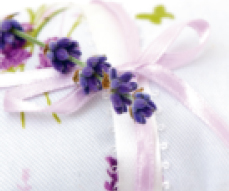
Decorate your pillow with ribbon and a tapestry casing.
Place a piece of wadding on each piece of plain cotton and sew around all the sides. With the cotton sides together, sew around three sides. Turn the right way out. Stuff the aromatic herb mixture into the sachet through the remaining open side. Stitch up the fourth side carefully.
Now make the outer casing of the pillow in the same way. Place the right sides of the fabric together, sewing around three sides and turning the right side out. Leave the fourth side open. Turn in the edges of the open side to neaten. Finish with several ribbons used as ties, or use poppers. Decorate the pillow with lace, tassels or ribbons. Slip the sachet inside.
For children, cut two equal-sized remnants of material into the shape of a frog, snake or rabbit, sew together and stuff with lavender or other scented herbs for them to take to bed or place under their pillows. Since most children like its sweet scent, a soft lavender toy can be a great aid in helping to dispel anxiety and ensuring a restful night's sleep.
Sweet bags are small sachets of powdered aromatics that have been used for centuries to perfume gloves, linen and scarves. They were also used to scent writing paper, handkerchiefs and underwear. Traditionally, Indian shawls were scented with patchouli oil, not only for its exotic fragrance, but also for the very practical reason that it protected the cloth against moths. All kinds of powdered herbs, petals or spices can be used in making sweet bags, although those with insect-repellent properties such as lavender, artemisia or lemon balm are amongst the most traditional plants used. The sweet bag below is based on an eighteenth-century recipe.

Ingredients:
Handful each of dried lavender, dried marjoram, dried lemon peel
4 cups orris root powder
Orange peel and dried rose petals
30 drops essential oil (10 each of cypress, clove and nutmeg)
Bags:
5 cotton pads
5 circular place mats or dressing table mats
20cm (8in) in diameter or lengths of ribbon, 7.5cm (3in) wide
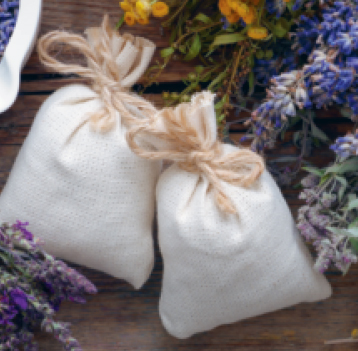
Use sweet bags of lavender to fragrance underwear, handkerchiefs or writing paper.
Using a pestle and mortar, crush the dried herbs to a rough-textured powder. Add the orris root powder. On each cotton pad, put two drops of each of the essential oils. Put these, together with the crushed herbs and orris root mixture into a sealed jar or tin for one week to infuse.
Divide the herb mixture into five portions, including a cotton pad with each. Make the sweet bag by folding each mat in half, then wrapping into a cone shape. Sew the edges of the outer layer to make the cone secure. Fill it with the herb mixture then draw together the inner folds of the cone to enclose the mixture. Sew together. Alternatively, use ribbon folded into an envelope shape, stuffed with herbs and then stitched to secure.
Tussie mussies are small scented posies that were used to combat unpleasant smells at a time when washing was a luxury. Like the pomander, they were used to deter infection as well as for the enjoyment of their fragrance. In medieval times, fragrant herbs were used to prevent the spread of contagious diseases: rue, sage, wormwood, rosemary and lavender in particular were employed in this respect. The herb posies were frequently hung from the belt as a protection when travelling.
Later, under the Elizabethans, tussie mussies became an object of romance and herbal posies were exchanged between lovers, with different flowers carrying their own secret message. For example, roses declared love while lavender meant silence. Marigolds signified happiness and marjoram wished fruitfulness on the recipient. The Victorians formalised the arrangement of the tussie mussie, making the herbs, flowers and leaves more deliberately concentric. As its symbolism and the use of its secret language faded, it became simply an offering for special occasions.
A tussie mussie still makes a unique and charming gift today, and can be given as a gesture of intimacy.

A fresh tussie mussie:
Freesias, blue hyacinths, roses
Pinks, primulas, common primroses
Mint, fennel, marjoram
Rosemary, chives
Raffia
Make small posies from a selection of flowers and herbs. Bind the stems together with raffia.
You can also make tussie mussies from a selection of dried herbs and flowers by binding the stems together with floristry wire. Push each posy through the centre of a paper doily and secure with a decorative ribbon. For extra fragrance, add a few drops of essential oils such as lavender or geranium into the middle of the posy. Place in a sealed brown paper bag. Keep away from light and heat for at least two weeks to allow the oils to infuse.
In aromatherapy, a few drops of lavender oil added to a warm bath before retiring has been shown to help prevent insomnia. Indeed, lavender has been used for bathing since Roman times and its name is generally thought to have derived from the Latin lavare – to wash. To maintain the tradition, make yourself a simple muslin or cotton bag approximately 10x15cm (4x6in) with a drawstring opening, so that it can be re-used easily. Then collect fresh flowers and leaves of lavender from the garden, together with other aromatic herbs such as lemon balm, lemon verbena or rosemary if desired, directly before the bath. Attach the fresh-scented sachet to the hot tap by the drawstring while the bath is running. Children especially like concocting their own bath blends. The scent is better than you will find in any commercial or dried preparation.
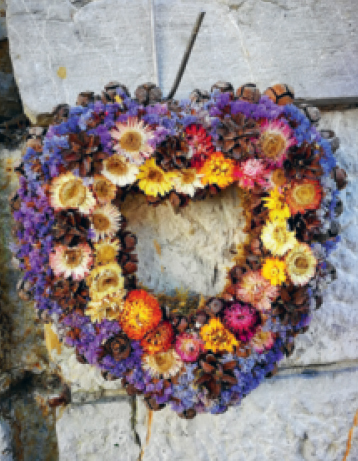
Aromatic wreaths are a wonderful welcome to the home.
An extremely decorative way to display dried (or fresh) herbs is to make them into a simple wreath or garland. Make a base using thick florists’ wire: form it into a circle three strands thick and no more than 30cm (12in) in diameter. Using fine wire, bind together small bunches of herbs that dry well such as lavender, oregano, bay or yarrow. The inclusion of some decorative leaves or a few rose buds can also add interest. Fix the bunches one at a time to the wreath base using wire or strong thread, laying each new bunch so it overlaps the former and conceals the wiring. Gradually work your way all around the wreath, always laying the bundles in the same direction until the circle is completed and full. Finally, attach a decorative ribbon to hang it.